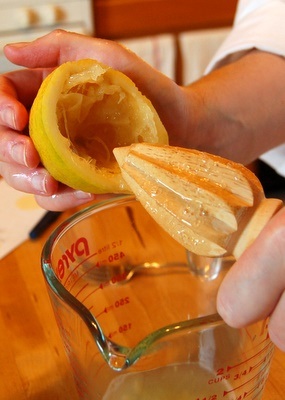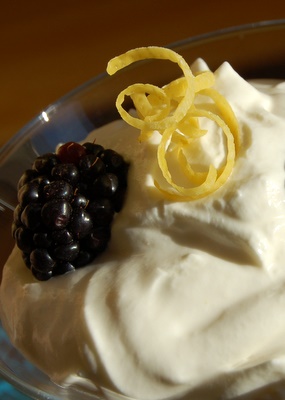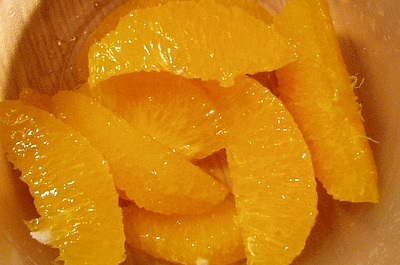
primary-image, l
(article, Helen Rennie)

primary-image, l
[%pageBreakSettings nobreak=true] p(blue). Editor's note: Helen Rennie wrote the Front Burner column from January to June 2007. When life gives you lemons, you can make way more than lemonade. (Particularly in winter, when hot chocolate sounds better anyway.) Fish, salad, tarts — few dishes leave my kitchen without getting a squirt of lemon, lime, or something citrusy. I’ve never met a citrus — oranges, grapefruits, tangerines, lemons, and limes — I didn’t love. And I wait for February the way most kids wait for Christmas, because then I’m able to get real citrus treats: blood oranges and Meyer lemons. The freezing weather that hit California recently means that these precious fruits are now harder to find. But not even price hikes could stop me from snagging a few golden Meyer lemons. Let’s hope for better luck next year. What's a blood orange? The blood orange (also known as the Maltese orange) is a variety of orange with crimson flesh and sometimes a red blush on its skin. Types include the Tarocco (Italian), Sanguinello (Spanish), and the Moro (grown mostly in California). You can use them just like any other orange. What's a Meyer lemon? The Meyer lemon is a cross between a lemon and a mandarin orange that originated in China; it was introduced to the United States in 1908 by plant explorer Frank Meyer. It has a sweeter, less acidic flavor than the everyday supermarket lemon and a smooth, very fragrant skin. You can use it like any other lemon, and it’s particularly fabulous in desserts. What’s the best way to store whole citrus? Refrigerating citrus in the bottom drawer of your fridge will make them last about a month before they are cut. But if you go through them in less than five days, feel free to leave them out at room temperature. What do you do with the rest of the lemon if all you need is a squirt? I put mine in a Ziploc bag and keep it in the fridge. As long as the juice stays in the citrus, it doesn’t get exposed to air and stays just as aromatic and natural-tasting. Even after they’re cut, citrus fruit can stay in the fridge for at least a week, and keeping them in a plastic bag prevents them from drying up. [%image "reamer" float="left" caption="A ribbed juicer can be handy."] What if I don’t have a juicer to catch the seeds? Don’t worry, I don’t have one either. Juicers are great for making lemonade or for when you need a ton of juice, but for just a few tablespoons of juice, there are other alternatives. If I only need a squirt, I’ll squeeze a citrus half with one hand while holding the other hand underneath to catch the seeds. It’s a good way to improvise a sieve without having to wash one. If your skin is really dry, or if you have a cut on your hand, this method might be painful, so you’ll want to go with plan B: Put a sieve over a small bowl to catch the seeds and squeeze your citrus halves into it. A little ribbed juicer with a handle comes in handy, but if you don’t have one, stick a fork inside your citrus half and press the fork tines against the inside of the citrus to press all the juice out. When do you use citrus zest instead of juice? The zest will give you much more aroma than the juice. It’s also a good way to add citrus flavor to your dish without additional sweetness or acidity. Juice will give you plenty of both, but it has less aroma than the zest. [%image featurette-image float="right" credit="Photo courtesy Helen Rennie" caption="Mousse makes the meal."] Is bottled lemon or lime juice good enough for most recipes? Those little plastic bottles of lemon and lime juice might look bright and happy, but the stuff that squirts out of them is best left right where it came from — in the bottle. I am in no way an ingredient snob. My balsamic vinegar is $5 and the wine I use for cooking is $3. But when it comes to citrus, I am adamant about the fruit being fresh. As soon as the juice is out of your citrus, it starts oxidizing, which makes it taste metallic and almost chemical. As an experiment, taste some freshly squeezed lemon juice and bottled lemon juice side by side, and see which one you prefer. What can you do with citrus besides squirting it on your fish? Lemons and limes make excellent salad dressings. I actually prefer them to vinegars for making vinaigrettes. Adding a squirt of lemon or lime to your soups will balance the saltiness of the broth and the sweetness of your vegetables and make them taste wonderfully rounded and complex. And any creamy and buttery sauce can use a squirt of citrus (usually lemon or lime) to cut through the fat. Lemons are not the only citrus that goes with seafood, and you don’t have to stop at a squirt. Adding whole sections of oranges or grapefruits makes for a more dramatic presentation and an exquisite combination of flavors and textures; they work particularly well on finfish and crab. [[block(sidebar). h1.Featured recipe]] Orange and grapefruit sections are also a welcome addition to any salad, from savory greens to a mixed-fruit bowl. Since citrus fruits usually play supporting roles, I like finding ways to let them steal the show. p(bio). Culinate columnist Helen Rennie is a food writer and cooking teacher living in Boston. Check out her blog, Beyond Salmon, for a post on sectioning oranges.

reamer, l

featurette-image, l

reference-image, l